Influence of Slag Composition on the Distribution Behavior of Cu between Liquid Sulfide and Cu-Containing Multicomponent Slag via Thermodynamic and Kinetic Assessment
Abstract
1. Introduction
2. Materials and Methods
3. Results
3.1. Kinetics of MgO Solubility in Multicomponent Slag
3.2. Cu2O Activity Coefficient Measurement Results
3.3. Simulation of Cu2O Contents in the Multicomponent Slag by Reaction with Matte
4. Discussion
5. Conclusions
- To simulate a change in the MgO content of the slag, the apparent dissolution rate of MgO in the Cu2O-FeOX-CaO-MgO-SiO2-Al2O3 slag under MgO saturation conditions was obtained at 1573 K. By assuming equilibrium with Ag at 1573 K, the activity coefficient of Cu2O in the slag was obtained as a function of slag composition. The activity coefficient of Cu2O in the slag was found to increase with the increasing CaO/Al2O3 ratio when the FeOX/SiO2 ratio in the slag was between 2.0 and 2.3. However, when the content of Al2O3 in the slag was less than approximately 5 mass%, the activity coefficients of Cu2O were almost the same as those in the Cu2O-FeOX-CaO-MgO-SiO2 slag. The empirical formula for the activity coefficients of Cu2O in the Cu2O-FeOX-CaO-MgO-SiO2-Al2O3 slag was also obtained using regression analysis and the equilibrated slag composition. Furthermore, the activity coefficients of Cu2O in FeOX-CaO-SiO2 slag with/without MgO and Al2O3 were accurately calculated by the empirical formula for various slag compositions.
- By the simulation model using the apparent dissolution rate of MgO and the empirical formula for Cu2O activity coefficients, the composition changes in Cu2O and MgO in the Cu2O-FeOX-CaO-MgO-SiO2-Al2O3 slag were obtained with the reaction of FeS-based matte at 1573 K. The simulated composition changes in Cu2O and MgO in the slag was in good agreement with the measured values. In addition, the copper solubility in the FeOX-CaO-SiO2-MgO slag calculated by the present model with varying Cu content in the matte showed good agreement with previous experimental results. By varying the mass ratio of the slag and the matte, the simulated Cu content in the typical copper smelting slag agreed more with the measured value than with the prior simulation results. It was found that the copper content in the slag decreased as the initial mass of the liquid iron sulfide was increased.
- The effect of slag composition on the behavior of Cu between 1 ton of copper-containing slag and liquid iron sulfide was investigated using the present simulation model. The Cu content in the slag decreased as the ratios of CaO/SiO2 and FeOX/SiO2 in the slag were increased due to the increase in the activity coefficient of Cu2O. On the other hand, the Cu content in the matte increased at least four times more than it decreased in the slag. To improve the sulfurization of copper in the slag, it is important to control the CaO content of the Cu-containing slag.
Author Contributions
Funding
Acknowledgments
Conflicts of Interest
References
- Yumashev, A.; Ślusarczyk, B.; Kondrashev, S.; Mikhaylov, A. Global Indicators of Sustainable Development, Evaluation of the Influence of the Human Development Index on Consumption and Quality of Energy. Energies 2020, 13, 2768. [Google Scholar] [CrossRef]
- Shi, C.; Meyer, C.; Behnood, A. Utilization of copper slag in cement and concrete. Resour. Conserv. Recycl. 2008, 52, 1115–1120. [Google Scholar] [CrossRef]
- Ayano, T.; Sakata, K. Durability of concrete with copper slag fine aggregate. Spec. Pub. 2000, 192, 141–158. [Google Scholar]
- Sverdrup, H.U.; Ragnarsdottir, K.V.; Koca, D. On modelling the global copper mining rates, market supply, copper price and the end of copper reserves. Resour. Conserv. Recycl. 2014, 87, 158–174. [Google Scholar] [CrossRef]
- Zhang, J.; Qi, Y.H.; Yan, D.L.; Xu, H.C. A new technology for copper slag reduction to get molten iron and copper matte. J. Iron Steel Res. Int. 2015, 22, 396–401. [Google Scholar] [CrossRef]
- Maweja, K.; Mukongo, T.; Mutombo, I. Cleaning of a copper matte smelting slag from a water-jacket furnace by direct reduction of heavy metals. J. Hazard. Mater. 2009, 164, 856–862. [Google Scholar] [CrossRef] [PubMed]
- Zhang, B.J.; Niu, L.P.; Zhang, T.A.; Li, Z.Q.; Zhang, D.L.; Zheng, C. Alternative reduction of copper matte in reduction process of copper slag. Iron Steel Inst. Jpn. Int. 2017, 57, 775–781. [Google Scholar] [CrossRef]
- Kim, S.J.; Suzuki, J.; Gao, X.; Ueda, S.; Kitamura, S.Y. A kinetic model to simulate the reaction between slag and matte for the production of ferromanganese alloy from steelmaking slag. J. Sustain. Metall. 2016, 2, 141–151. [Google Scholar] [CrossRef]
- Shin, S.H.; Kim, S.J. Development of Kinetic Model for Reactions Between Cu-Containing Multicomponent Slag and Liquid Sulfide Using Coupled Reaction Model. Metall. Trans. B 2018, 49, 3074–3085. [Google Scholar] [CrossRef]
- Ohguchi, S.; Robertson, D.G.C.; Deo, B.; Grieveson, P.; Jeffes, J.H. Simultaneous dephosphorization and desulphurization of molten pig iron. Ironmak. Steelmak. 1984, 11, 202–213. [Google Scholar]
- Kitamura, S.Y.; Kitamura, T.; Aida, E.; Sakomura, R.; Kaneko, T.; Nuibe, T. Development of analysis and control method for hot metal dephosphorization process by computer simulation. Iron Steel Inst. Jpn. Int. 1991, 31, 1329–1335. [Google Scholar] [CrossRef]
- Knoop, W.; Deo, B.; Snoijer, A.B.; Unen, G.V.; Boom, R. A dynamic slag-droplet model for the steelmaking process. In Proceedings of the 4th international conference on molten slags and fluxes, ISIJ, Tokyo, Japan, 8–11 June 1992; pp. 302–307. [Google Scholar]
- Graham, K.J.; Irons, G.A. Coupled Kinetic Phenomena in Ladle Metallurgy. In Proceedings of the 3rd International Conference on Process Development in Iron and Steelmaking (SCANMET III), MEFOS, Lulea, Sweden, 8–11 June 2008; Volume 1, pp. 385–396. [Google Scholar]
- Harada, A.; Maruoka, N.; Shibata, H.; Kitamura, S.Y. A kinetic model to predict the compositions of metal, slag and inclusions during ladle refining: Part 1. Basic concept and application. Iron Steel Inst. Jpn. Int. 2013, 53, 2110–2117. [Google Scholar] [CrossRef]
- Sakichi, G. Copper Metallurgy-Practice and Theory; Institution of Mining and Metallurgy: London, UK, 1975; pp. 23–34. [Google Scholar]
- Sakichi, G. Copper and Nickel Converters; Johns, R.E., Ed.; TMS AIME: Warrendale, PA, USA, 1979; pp. 33–54. [Google Scholar]
- Shimpo, R.; Watanabe, S.; Goto, S.; Ogawa, O. Advances in Sulphide Smelting; TMS AIME: Warrendale, PA, USA, 1983; Volume 1, pp. 295–316. [Google Scholar]
- Kemori, N.; Kimura, T.; Mori, Y.; Goto, S. Pyrometallurgy’87; Institution of Mining and Metallurgy: London, UK, 1987; pp. 647–666. [Google Scholar]
- Bustos, M.; Sánchez, M. The modelling of pyrometallurgical process by a thermodynamical approach. Proc. Conf. Copp. 1987, 87, 473–487. [Google Scholar]
- Nagamori, M.; Mackey, P.J. Thermodynamics of copper matte converting: Part I. Fundamentals of the noranda process. Metall. Trans. B 1978, 9, 255–265. [Google Scholar] [CrossRef]
- Nagamori, M.; Mackey, P.J. Thermodynamics of copper matte converting: Part II. Distribution of Au, Ag, Pb, Zn, Ni, Se, Te, Bi, Sb and as between copper, matte and slag in the noranda process. Metall. Trans. B 1978, 9, 567–579. [Google Scholar] [CrossRef]
- Nagamori, M.; Chaubal, P.C. Thermodynamics of copper matte converting: Part III. Steady-state volatilization of Au, Ag, Pb, Zn, Ni, Se, Te, Bi, Sb, and as from slag, matte, and metallic copper. Metall. Trans. B 1982, 13, 319–329. [Google Scholar] [CrossRef]
- Nagamori, M.; Chaubal, P.C. Thermodynamics of copper matte converting: Part IV. A priori predictions of the behavior of Au, Ag, Pb, Zn, Ni, Se, Te, Bi, Sb, and as in the Noranda process reactor. Metall. Trans. B 1982, 13, 331–338. [Google Scholar] [CrossRef]
- Wang, C.; Nagasaka, T.; Hino, M.; Ban-Ya, S. Copper distribution between molten FeS-NaS0.5 flux and carbon saturated iron melt. Iron Steel Inst. Jpn. Int. 1991, 31, 1300–1308. [Google Scholar] [CrossRef]
- Henao, H.M.; Pizarro, C.; Font, J.; Moyano, A.; Hayes, P.C.; Jak, E. Phase Equilibria of “Cu2O”-“FeO”-CaO-MgO-Al2O3 Slags at PO2 of 10−8.5 atm in Equilibrium with Metallic Copper for a Copper Slag Cleaning Production. Metall. Mater. Trans. B 2010, 41, 1186–1193. [Google Scholar] [CrossRef]
- Yamaguchi, K.; Ueda, S.; Takeda, Y. Phase equilibrium and thermodynamic properties of SiO2–CaO–FeOx slags for copper smelting—research achievements of Professor Yoichi Takeda. Scand. J. Metall. 2005, 34, 164–174. [Google Scholar] [CrossRef]
- Ban-Ya, S. Mathematical expression of slag-metal reactions in steelmaking process by quadratic formalism based on the regular solution model. Iron Steel Inst. Jpn. Int. 1993, 33, 2–11. [Google Scholar] [CrossRef]
- Takeda, Y.; Ishiwata, S.; Yazawa, A. Distribution equilibria of minor elements between liquid copper and calcium ferrite slag. Trans. Jap. Inst. Met. 1983, 24, 518–528. [Google Scholar] [CrossRef]
- Henao, H.M.; Hayes, P.C.; Jak, E. Phase Equilibria of “Cu2O”-“FeO”-SiO2-CaO Slags at PO2 at 10−8 atm in Equilibrium with Metallic Copper. In Proceedings of the Ninth International Conference on ‘Molten slags, fluxes and salts (Molten 12)’, Beijing, China, 27–31 May 2012. [Google Scholar]
- Nie, D.; Panfilova, E.; Samusenkov, V.; Mikhaylov, A. E-Learning Financing Models in Russia for Sustainable Development. Sustainability 2020, 12, 4412. [Google Scholar] [CrossRef]
- Sugiyama, K.; Ueda, S.; Gao, X.; Kim, S.; Kitamura, S.Y. Measurement of Interaction Parameter between Cu and Al in Molten High Al Steel. Iron Steel Inst. Jpn. Int. 2017, 57, 625–629. [Google Scholar] [CrossRef]
- Yazawa, A.; Takeda, Y. Equilibrium relations between liquid copper and calcium ferrite slag. Trans. Jpn. Inst. Met. 1982, 23, 328–333. [Google Scholar] [CrossRef]
- Jang, J.S.; Park, S.S.; Kim, J.Y. The Recovery Method of Valuable Metals Included in Slag at Copper Smelter. Korea Patent No. 10-2012-0100157, 23 March 2014. [Google Scholar]
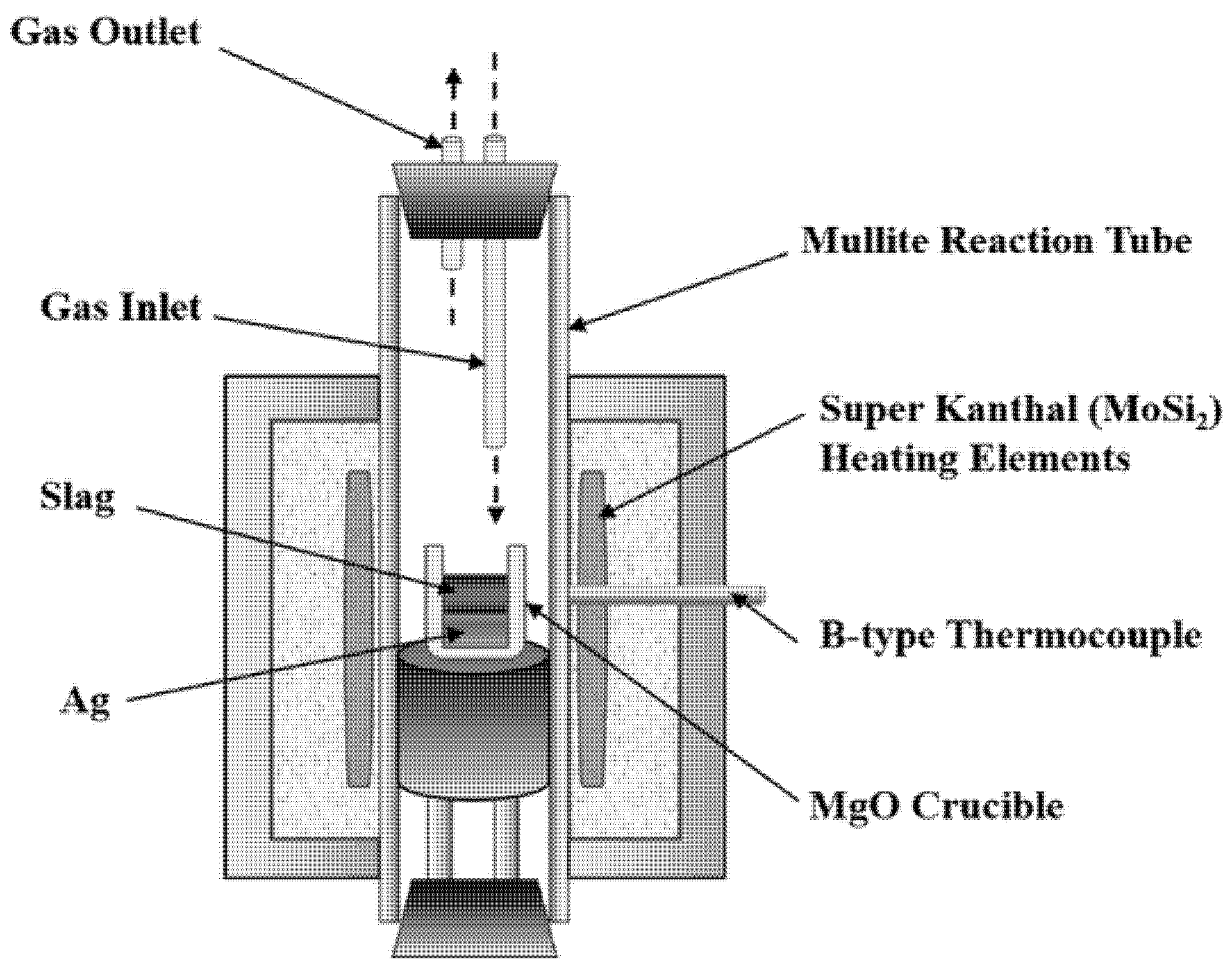


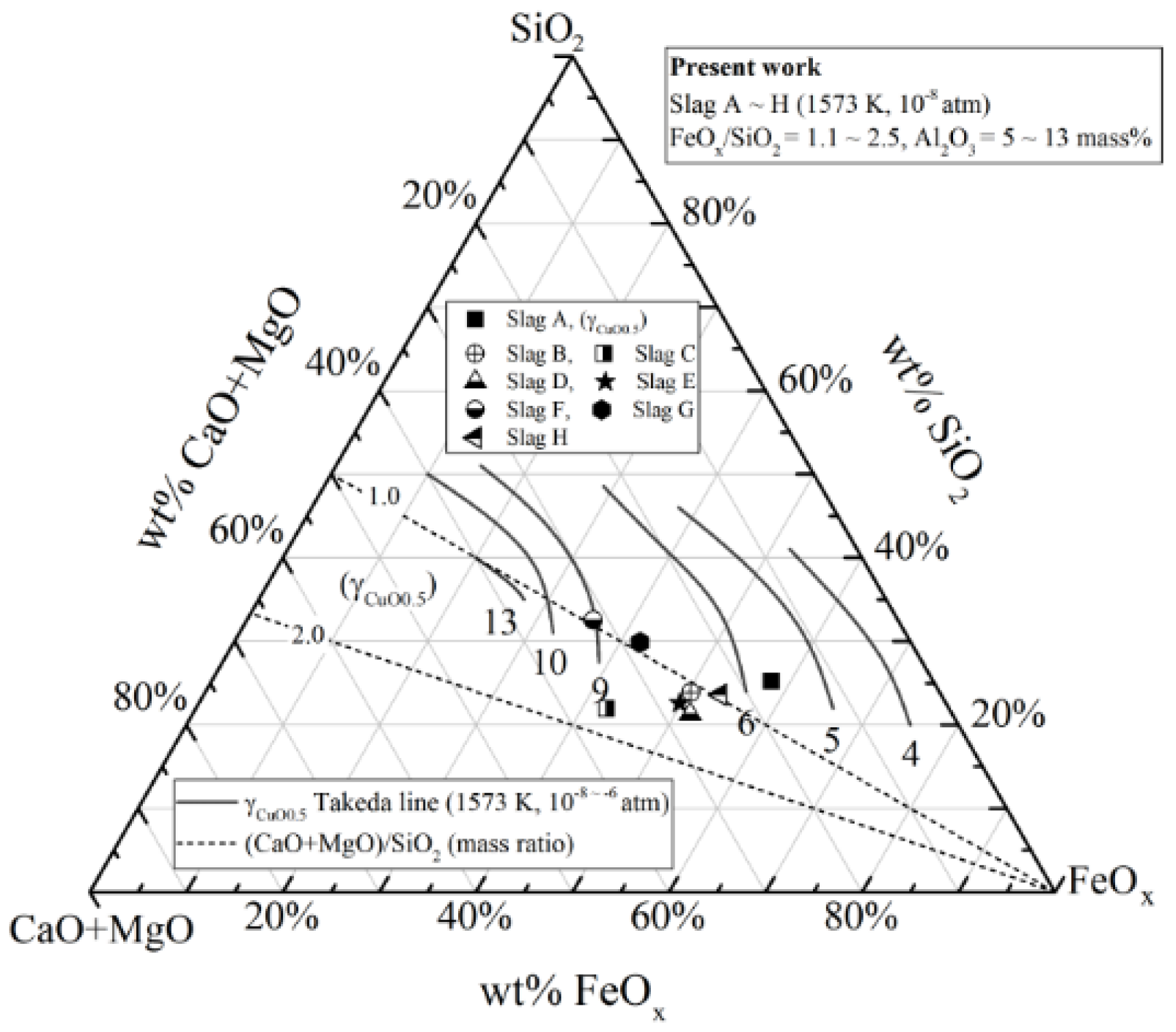
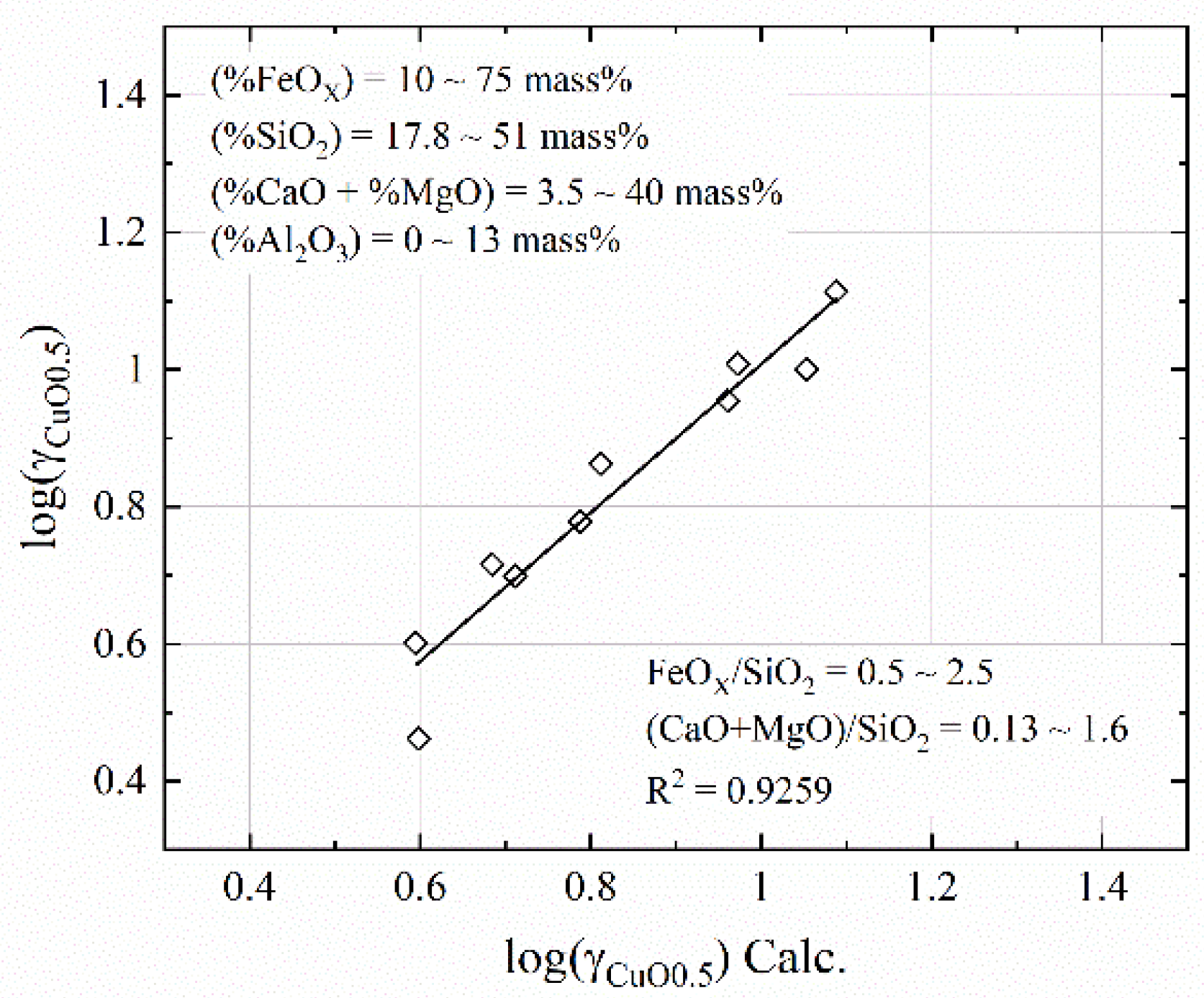
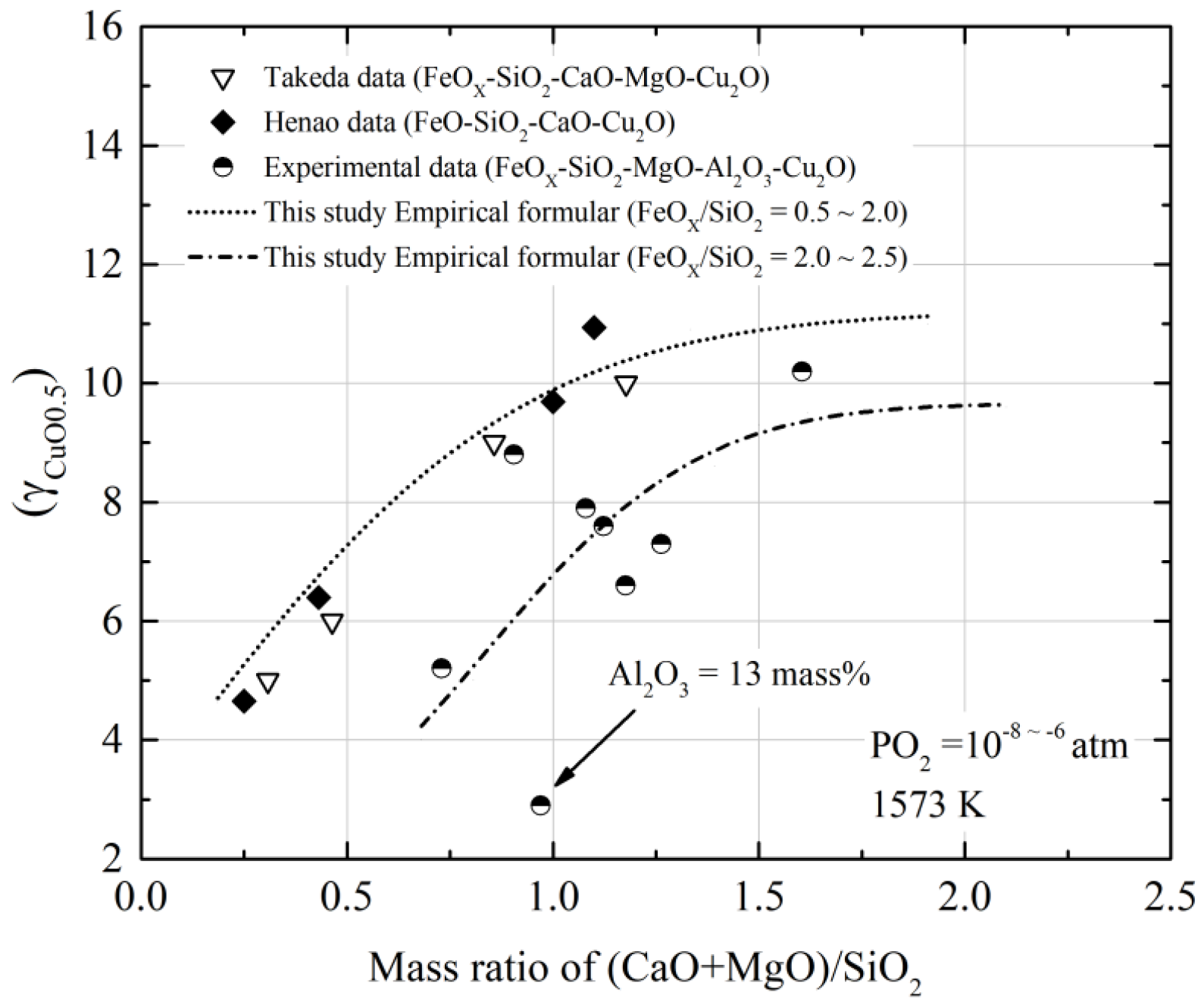

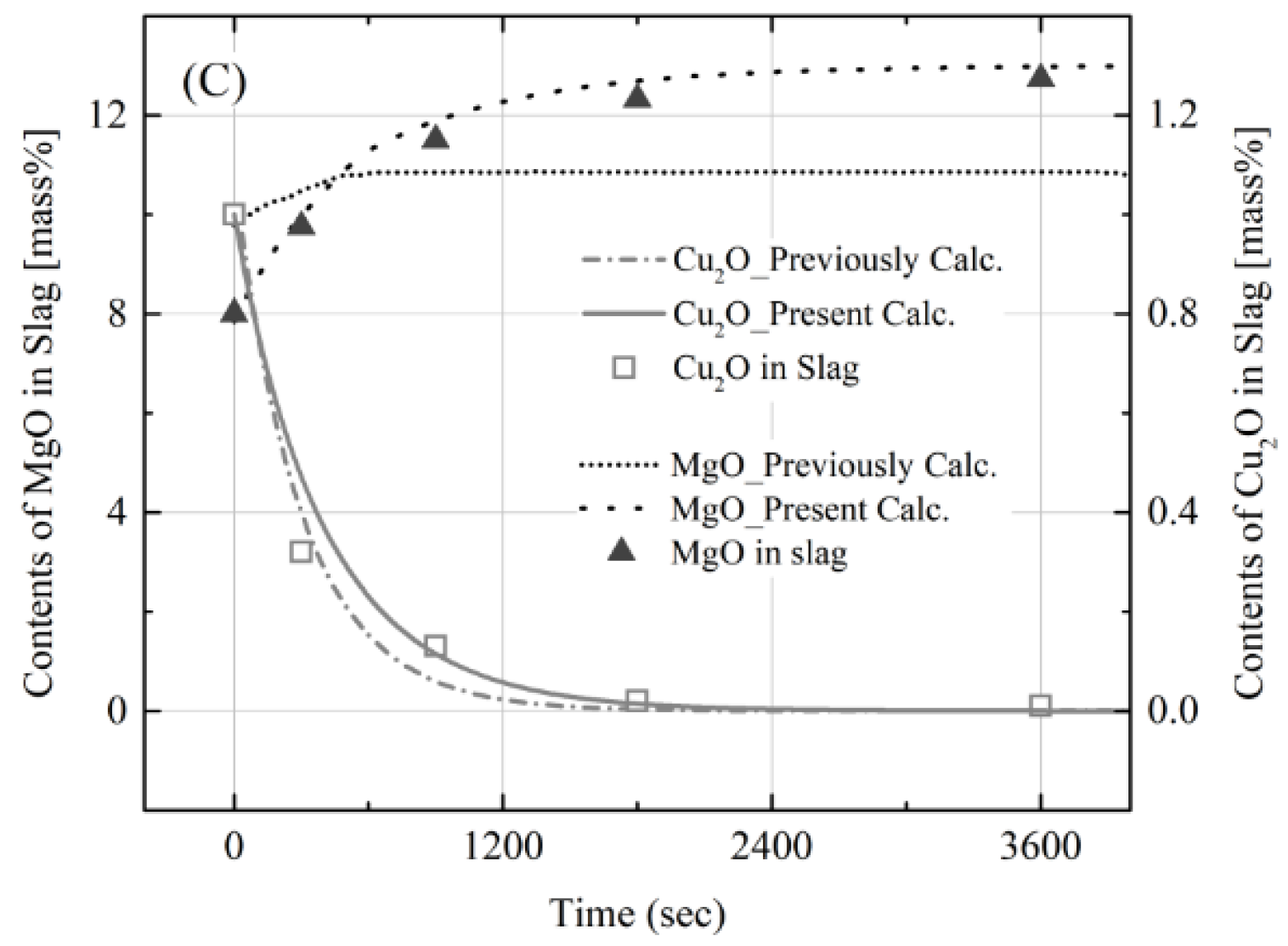
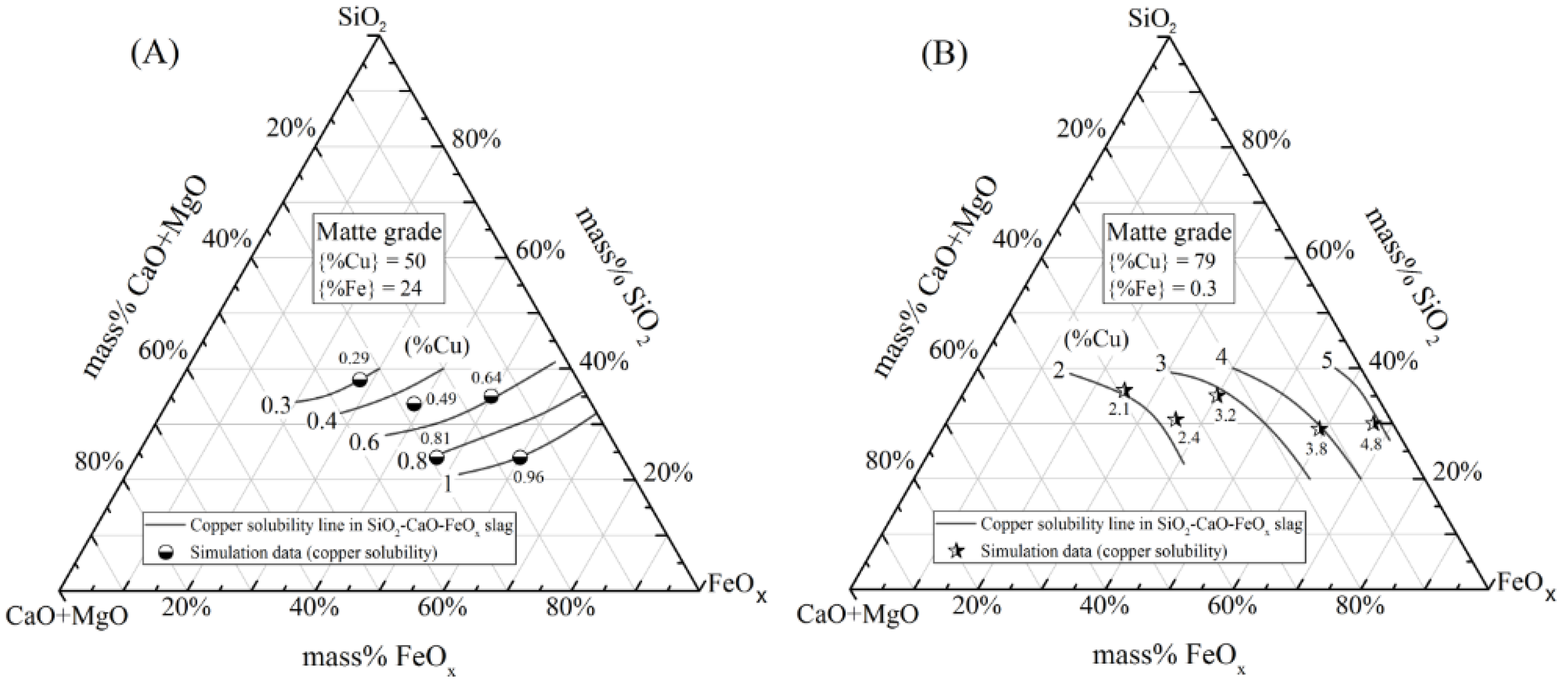
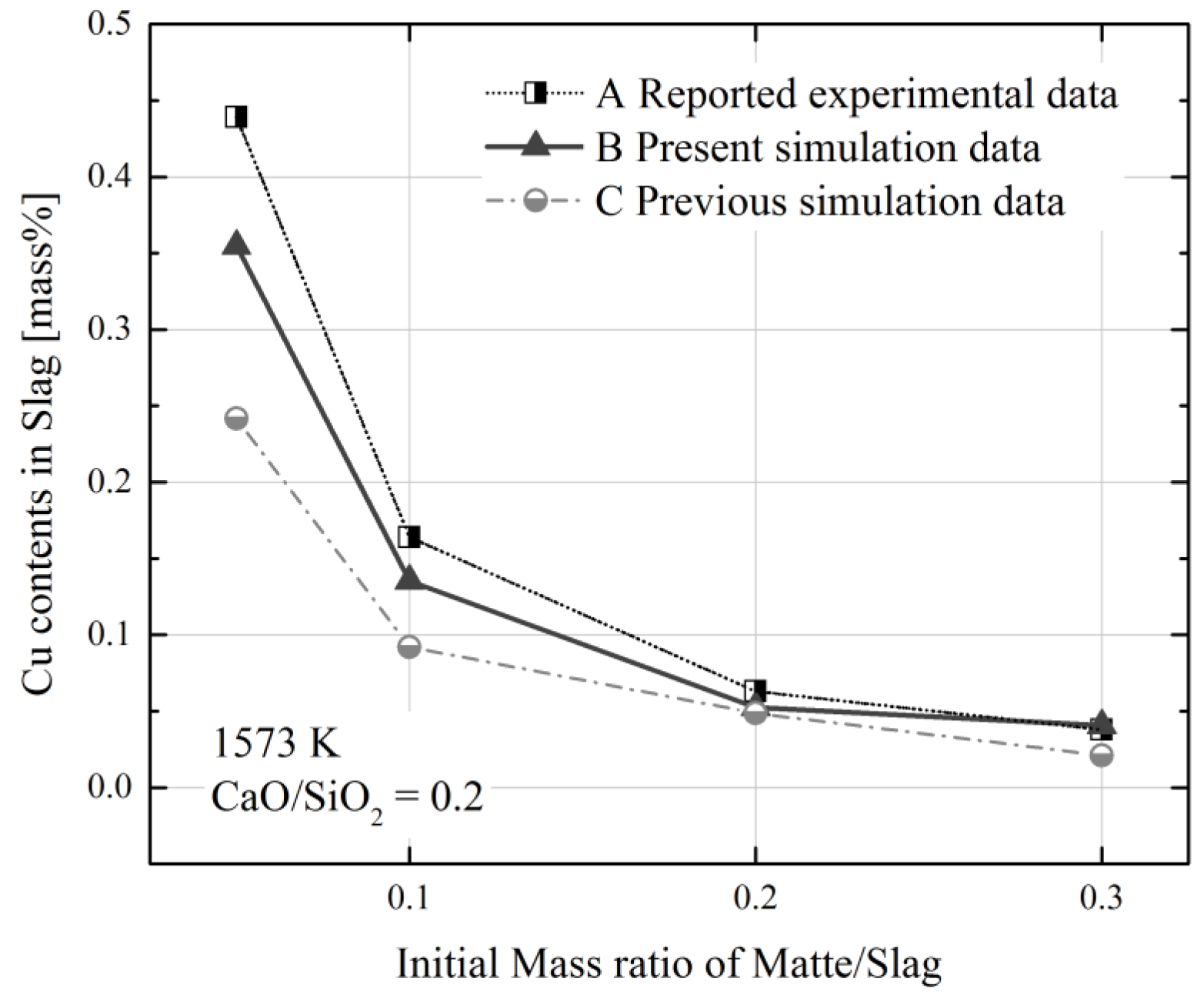
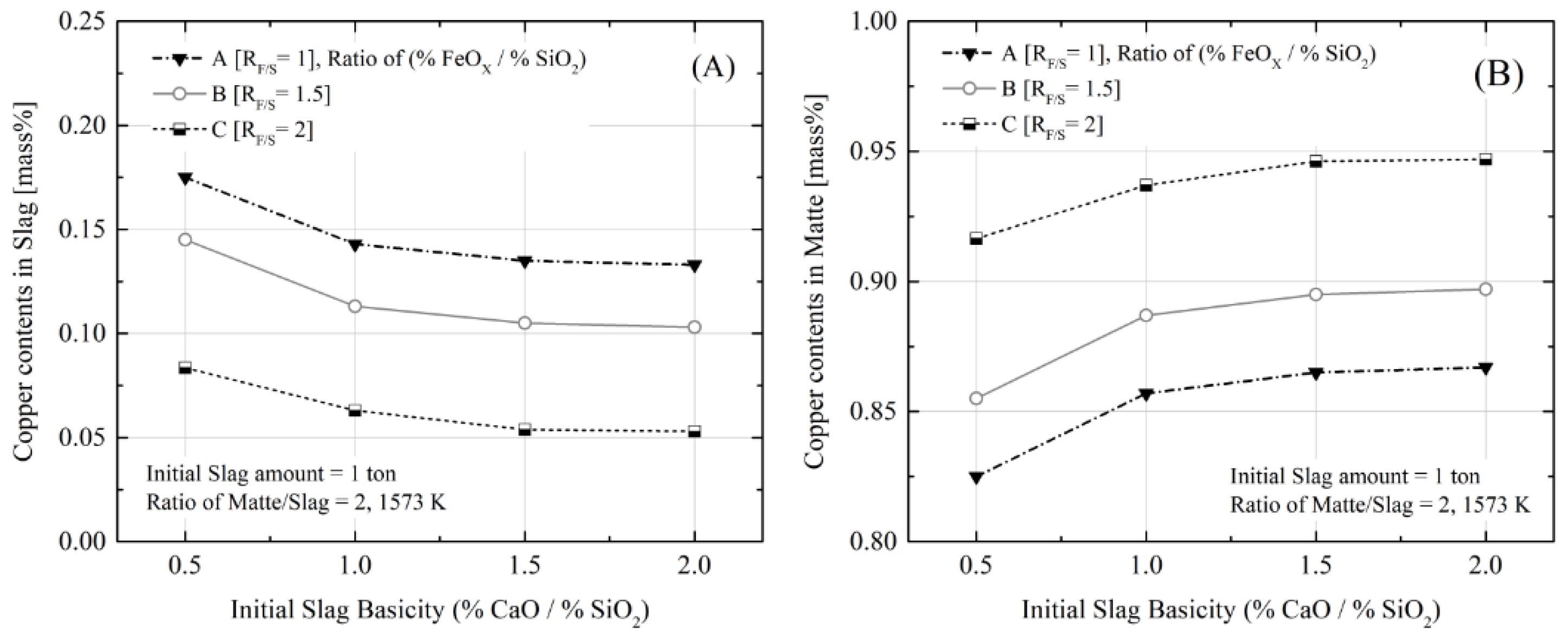
| Experiment | Temp (K) | Composition (mass%) | ||||||
|---|---|---|---|---|---|---|---|---|
| FeO | Fe2O3 | Cu2O | SiO2 | Al2O3 | CaO | MgO | ||
| A | 1573 | 42 | 7 | 2 | 33 | 5 | 6 | 5 |
| B | 37 | 6 | 2 | 30 | 5 | 15 | 5 | |
| C | 33 | 5 | 2 | 25 | 5 | 25 | 5 | |
| D | 38 | 6 | 1 | 30 | 5 | 15 | 5 | |
| E | 38.5 | 6 | 0.5 | 30 | 5 | 15 | 5 | |
| F | 28 | 5 | 2 | 37 | 5 | 18 | 5 | |
| G | 35 | 6 | 2 | 28 | 7 | 17 | 5 | |
| H | 35 | 6 | 2 | 28 | 13 | 11 | 5 | |
| No. | Temp (K) | Composition (mass%) | ||||||||
|---|---|---|---|---|---|---|---|---|---|---|
| Slag | Matte | |||||||||
| FeO | Fe2O3 | Cu2O | SiO2 | Al2O3 | CaO | MgO | FeS | CaS | ||
| I | 1573 | 42 | - | 1 | 24 | 6 | 19 | 8 | 100 | 0 |
| J | 45 | 8 | 1 | 27 | 6 | 5 | 8 | 100 | 0 | |
| K | 45 | 8 | 1 | 27 | 6 | 5 | 8 | 90 | 10 | |
| Experiment | Temp (K) | Composition (mass%) | γCuO0.5 | ||||||
|---|---|---|---|---|---|---|---|---|---|
| Slag | Silver | ||||||||
| FeOx | Cu2O | SiO2 | Al2O3 | CaO | MgO | Cu | |||
| A | 1573 | 55.2 | 0.1 | 24 | 4.7 | 6 | 10 | 1.7 | 5.2 |
| B | 47.8 | 0.1 | 22.7 | 4.9 | 15 | 9.7 | 1.7 | 7.9 | |
| C | 40.7 | 0.1 | 20.2 | 4.8 | 25 | 9.6 | 1.8 | 10.2 | |
| D | 48.9 | 0.1 | 21.2 | 4.9 | 15 | 10.1 | 0.9 | 6.6 | |
| E | 47.3 | 0.1 | 22.6 | 4.7 | 15 | 10.5 | 0.5 | 7.6 | |
| F | 34.2 | 0.1 | 32 | 4.8 | 18 | 11.2 | 2 | 8.8 | |
| G | 45.9 | 0.1 | 20.9 | 6.7 | 17 | 9.8 | 1.7 | 7.3 | |
| H | 46.7 | 0.2 | 20.6 | 12.5 | 11 | 9.2 | 1.6 | 2.9 | |
| Calculation | Temp (K) | Composition (mass%) | |||||
|---|---|---|---|---|---|---|---|
| Slag | Matte | ||||||
| FeOX | SiO2 | CaO | MgO | Fe | Cu | ||
| A-1 | 1573 | 29 | 31 | 35 | 5 | 24 | 50 |
| A-2 | 39 | 34 | 22 | 5 | 24 | 50 | |
| A-3 | 50 | 35 | 10 | 5 | 24 | 50 | |
| A-4 | 48 | 24 | 23 | 5 | 24 | 50 | |
| A-5 | 60 | 25 | 10 | 5 | 24 | 50 | |
| B-1 | 25 | 36 | 34 | 5 | 0.3 | 79 | |
| B-2 | 36 | 31 | 28 | 6 | 0.3 | 79 | |
| B-3 | 40 | 35 | 20 | 5 | 0.3 | 79 | |
| B-4 | 59 | 29 | 7 | 5 | 0.3 | 79 | |
| B-5 | 67 | 30 | 2 | 1 | 0.3 | 79 | |
| Calc. No. | Temp (K) | Slag | Matte | |||||||
|---|---|---|---|---|---|---|---|---|---|---|
| Mass (g) | Composition (mass%) | Comp. (mass%) | Mass (g) | |||||||
| FeOX | Cu2O | SiO2 | Al2O3 | CaO | MgO | FeS | ||||
| C | 1573 | 100 | 50 | 1 | 33 | 5 | 6 | 5 | 100 | 5–30 |
| Calc. No. | Temp (K) | Slag | Matte | |||||||
|---|---|---|---|---|---|---|---|---|---|---|
| Weight (kg) | Composition (mass%) | Comp. (mass%) | Weight (kg) | |||||||
| FeOX | Cu2O | SiO2 | Al2O3 | CaO | MgO | FeS | ||||
| D-1 | 1573 | 1000 | 53 | 1 | 24 | 5 | 12 | 5 | 100 | 2000 |
| D-2 | 49 | 1 | 20 | 5 | 20 | 5 | ||||
| D-3 | 43 | 1 | 18 | 5 | 28 | 5 | ||||
| D-4 | 40 | 1 | 16 | 5 | 33 | 5 | ||||
| E-1 | 44 | 1 | 30 | 5 | 15 | 5 | ||||
| E-2 | 38 | 1 | 25 | 5 | 26 | 5 | ||||
| E-3 | 34 | 1 | 22 | 5 | 33 | 5 | ||||
| E-4 | 29 | 1 | 20 | 5 | 40 | 5 | ||||
Publisher’s Note: MDPI stays neutral with regard to jurisdictional claims in published maps and institutional affiliations. |
© 2021 by the authors. Licensee MDPI, Basel, Switzerland. This article is an open access article distributed under the terms and conditions of the Creative Commons Attribution (CC BY) license (http://creativecommons.org/licenses/by/4.0/).
Share and Cite
Shin, S.-H.; Kim, S.-J. Influence of Slag Composition on the Distribution Behavior of Cu between Liquid Sulfide and Cu-Containing Multicomponent Slag via Thermodynamic and Kinetic Assessment. Metals 2021, 11, 150. https://doi.org/10.3390/met11010150
Shin S-H, Kim S-J. Influence of Slag Composition on the Distribution Behavior of Cu between Liquid Sulfide and Cu-Containing Multicomponent Slag via Thermodynamic and Kinetic Assessment. Metals. 2021; 11(1):150. https://doi.org/10.3390/met11010150
Chicago/Turabian StyleShin, Seung-Hwan, and Sun-Joong Kim. 2021. "Influence of Slag Composition on the Distribution Behavior of Cu between Liquid Sulfide and Cu-Containing Multicomponent Slag via Thermodynamic and Kinetic Assessment" Metals 11, no. 1: 150. https://doi.org/10.3390/met11010150
APA StyleShin, S.-H., & Kim, S.-J. (2021). Influence of Slag Composition on the Distribution Behavior of Cu between Liquid Sulfide and Cu-Containing Multicomponent Slag via Thermodynamic and Kinetic Assessment. Metals, 11(1), 150. https://doi.org/10.3390/met11010150





